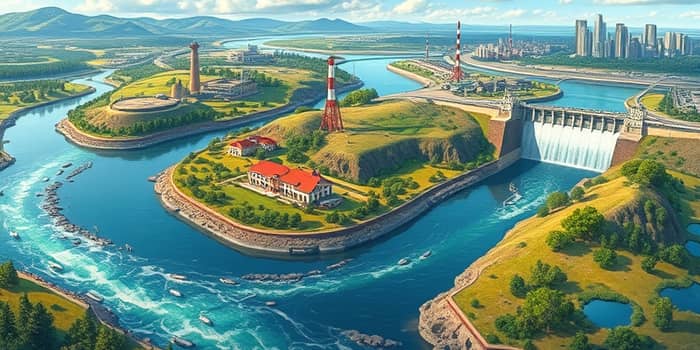
In the interconnected web of modern civilization, water stands out as foundation for global economic activity. From irrigated fields and industrial plants to hydropower dams and urban centers, every facet of growth relies on reliable access to freshwater. Yet, as demand surges and ecosystems degrade, mismanagement threatens jobs, livelihoods, and geopolitical stability worldwide.
By 2050, total water use could climb by 20–50% above today’s levels, with industry and households driving the sharpest increases. Agriculture—the largest consumer—faces a projected 19% rise in demand, and by 2040, 40% of all irrigated lands will endure increased disease burden and lost productivity. Meanwhile, the combined economic value of water and freshwater ecosystems is estimated at US$58 trillion annually, equivalent to 60% of global GDP.
Direct uses contribute US$7.5 trillion, led by industry (US$5.1 trillion), households (US$1.5 trillion), and agriculture (US$380 billion), while transport, hydropower, and recreation add another US$460 billion each year. Ecosystem services—flood mitigation, carbon storage, biodiversity support—deliver an indirect US$50 trillion in annual benefits. Yet, 40% of the world’s population already faces water scarcity, with 1.6 billion experiencing economic scarcity due to insufficient infrastructure.
Understanding these numbers underscores the urgency of sustainable management.
Every major industry draws on freshwater supplies—and every shortage ripples through the economy.
Irrigated agriculture faces extreme stress on 40% of its land by 2040, threatening food security and farmer incomes. In manufacturing and textiles, water shortages can halt production lines, drive up prices, and force relocation. Power plants—hydro and thermal—risk output drops during droughts, pushing utilities to expensive backup sources.
Meanwhile, lack of sanitation and clean water leads to preventable illnesses, with every US$1 invested in water and sanitation yielding an economic return of $4–$5.5 through lower health costs and higher workforce productivity.
As freshwater becomes scarcer, tensions mount. Shared basins in the Middle East, Asia, and Africa risk conflict as riparian states vie for dwindling supplies. Weak governance and poor infrastructure deepen inequalities, particularly in developing regions, while even wealthier nations face growing strains on urban water networks.
Unchecked, these dynamics can fuel migration, social unrest, and political instability. Recognizing shared water resources becoming flashpoints is vital for peacebuilding and cooperative management.
Rising global temperatures intensify droughts, floods, and sea-level rise, threatening freshwater availability. Aquatic ecosystems suffer: one-third of wetlands lost since 1970, freshwater wildlife down 83%, and two-thirds of major rivers no longer flow freely.
Pollution, over-extraction, and harmful subsidies degrade aquifers and surface waters, undermining resilience. Restoring rivers, lakes, and wetlands must be as much a priority as building pipelines and reservoirs to safeguard protected freshwater ecosystems.
Regions facing scarcity may experience sharp water price hikes, especially where desalination or nonrenewable sources fill the gap. Yet, some economies leverage comparative advantages to export virtual water embedded in agricultural and industrial goods, turning scarcity into an opportunity.
Market volatility often exceeds hydrologic uncertainty: speculation and policy shifts can magnify price swings. Adaptive strategies—water trading, demand management, and smart pricing—help stabilize supply and investment.
Securing water for people, industries, and ecosystems demands coordinated action:
Every dollar directed toward water and sanitation projects delivers a four- to fivefold economic return, supporting growth, health, and resilience.
Dr. Kirsten Schuijt of WWF International reminds us that essential cultural and spiritual values hinge on healthy water systems: “Water is one of the cornerstones upon which our shared future stands… Healthy rivers, lakes and wetlands are essential for water and food security, adapting to climate change and sustaining biodiversity.”
The UN and World Bank emphasize the high payoff: “Every $1 invested in improved sanitation translates into an average global economic return of $5.5.”
Water is more than a basic necessity: it is a strategic economic asset that underpins food, energy, industry, and health. With nearly half of global GDP at risk by mid-century, the time to act is now. Through targeted investments, innovative policies, and cross-border cooperation, we can safeguard this precious resource for future generations and build an economy that thrives on sustainable water stewardship.
References





